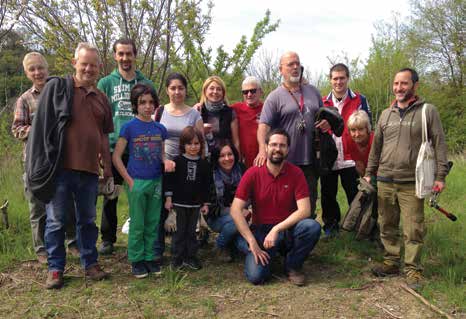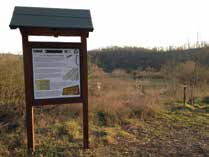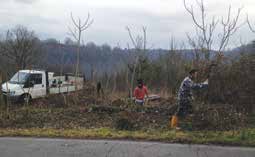September 1, 2016



An essay describing the AIA’s approach to archaeological site preservation was selected as one of eight that will be used by the U.S. Advisory Council on Historic Preservation (ACHP) to develop policy recommendations for the next presidential administration and Congress. The AIA essay was one of almost three dozen entries in a competition sponsored by the U.S. National Committee of the International Council on Monuments and Sites (US/ICOMOS) and the ACHP to “identify useful approaches to heritage law, policy, program strategy, and related preservation challenges from around the world that could help point the way to innovations in U.S. heritage practice over the next 50 years.” The winning essays will be published in a book called With a World of Heritage So Rich: Lessons from Across the Globe for U.S. Historic Preservation in Its Second 50 Years.
The competition, held on the fiftieth anniversary of the 1966 National Historic Preservation Act (NHPA), asked the question, “What can and should U.S. preservation law and federal programs look like for the next 50 years?” Entrants were asked to consider several major themes, including preservation as a tool for sustainable development, the challenges of climate change adaptation and resilience, democratizing preservation, promoting inclusiveness, rethinking established preservation processes and systems, and community-based valuation of heritage resources.
The paradigm adopted in 2009 by the AIA for its Site Preservation Program addresses many of these issues listed by US/ICOMOS and the ACHP. The AIA’s approach to site preservation is predicated on the idea that material conservation is not enough to ensure long-term site preservation and that the future of preservation lies in more holistic initiatives that use a portion of the funds for direct conservation and the rest to implement community-focused, site-specific preservation initiatives, including outreach, education, specialized training, and economic development. Under the guidelines of the revised program, the AIA has funded 29 projects on five continents, many of which have been featured in “Dispatches from the AIA.”
To learn more about the AIA program, visit www.archaeological.org/ sitepreservation. You can read more about the With a World of Heritage so Rich project at www.usicomos.org.
What do a precolonial Aztec chocolate drink, a nineteenthcentury American sponge cake, a Mycenaean lamb stew, and a Bronze Age Chinese pork dish have in common? They were all featured at a unique outreach event sponsored by the AIABoston Society in collaboration with Boston University’s archaeology, gastronomy, and culinary arts departments.
The AIA-Boston Society received an outreach grant for “Eating Archaeology,” a multidisciplinary event that challenged four teams of graduate students in archaeology, culinary arts, and food history to research and recreate ancient recipes from as long ago as the Greek Bronze Age to as recently as the American colonial period. Each team took on one culture and era—Bronze Age Greece, Bronze Age China, pre- Columbian Mesoamerica, and nineteenth- century America. Months of research and planning culminated in a day of presentations and tastings attended by more than 100 people.
Creative programs such as the one sponsored by the AIA-Boston Society bridge the gap between the academic community and the general public in new and engaging ways. Each year the AIA provides grants to AIA Local Societies to support community outreach programs. Grants are made twice a year, in the spring and fall. Other winning projects from the past year include:
To learn more about becoming an AIA Society member, please visit www.archaeological.org/join. To upgrade from subscriber to Society member, go to www.archaeological.org/upgrade.
Representatives from the AIA will attend the 22nd Annual Meeting of the European Association of Archaeologists (EAA) in Vilnius, Lithuania, from August 30 to September 4, 2016. Participating in the EAA meeting offers the AIA an opportunity to strengthen its relationship with one of the leading archaeological organizations in Europe, foster and build connections with European colleagues, and present the Institute’s mission and activities to a wider audience. AIA’s Director of Programs, Ben Thomas, together with colleagues from Europe and Australia, is co-organizing a session called “Visualizing the Past: Exploring Meaningful Approaches in Interpreting the Archaeological Record through Illustrations and Reconstructions,” during which he will present “Using Archaeological Reconstructions for Outreach and Community Engagement.” Thomas will also present a paper coauthored with AIA’s Senior Programs Coordinator, Meredith Langlitz, “Community Outreach and Engagement through Archaeology Fairs,” in the session “When Working with Many Partners: A Holistic Approach to Archaeological Research and Heritage Management.” In addition, the AIA will have a booth in the exhibit hall and will be represented at the meeting of the EAA Working Party on Heritage and Tourism.
 Join the AIA for this annual celebration of archaeology, which is expanding every year—last year more than 100,000 people participated in International Archaeology Day (IAD) events around the world. The National Park Service (NPS) has joined IAD as an official sponsor again this year, and will work with the AIA to promote IAD and NPS’s centennial. To read more about the program, visit www.archaeologyday.org.
Join the AIA for this annual celebration of archaeology, which is expanding every year—last year more than 100,000 people participated in International Archaeology Day (IAD) events around the world. The National Park Service (NPS) has joined IAD as an official sponsor again this year, and will work with the AIA to promote IAD and NPS’s centennial. To read more about the program, visit www.archaeologyday.org.
AIA’s longest-running public outreach program will start its 121st season in September. Once again, almost 100 lecturers will present more than 200 lectures at AIA Local Societies across the United States and Canada. This extremely popular program allows attendees to hear about the latest discoveries and issues in archaeology directly from working archaeologists. For a full list of lectures and to find one near you, visit www.archaeological.org/lectures.
The 118th AIA-SCS Joint Annual Meeting will take place in Toronto, Ontario, from January 5 to 8, 2017. Meeting information is available at www.archaeological.org/annualmeeting.
Each year the AIA offers fellowships and grants for travel, study, and publication to deserving scholars and students. To read more about the scholarships and grants and their application guidelines and requirements, visit www.archaeological.org/grants.
Site Preservation Grant to an innovative project that uses outreach and community development alongside direct conservation to sustainably preserve archaeological sites. Deadline: October 15
Graduate Student Travel Award to assist graduate students presenting papers at the AIA Annual Meeting with their travel expenses. Deadline: October 30
Harriet and Leon Pomerance Fellowship to support a project relating to Aegean Bronze Age archaeology. Deadline: November 1
Helen M. Woodruff Fellowship of the AIA and the American Academy in Rome to support a Rome Prize Fellowship for the study of archaeology or classical studies. Deadline: November 1
Cotsen Excavation Grants to provide excavation support for professional AIA members working around the world. Deadline: November 1
John R. Coleman Traveling Fellowship to honor the memory of John R. Coleman by supporting travel and study in Italy, the western Mediterranean, or North Africa. Deadline: November 1
Olivia James Traveling Fellowship for travel and study in Greece, Cyprus, the Aegean Islands, Sicily, southern Italy, Asia Minor, or Mesopotamia. Deadline: November 1
The Archaeology of Portugal Fellowship to support projects relating to the archaeology of Portugal. Deadline: November 1
AIA/DAI Exchange Fellowships to encourage and support scholarship on various aspects of archaeology and promote collaboration between North American and German archaeologists. AIA Fellowship for Study in the U.S. deadline: November 1. DAI Fellowship for Study in Berlin deadline: November 30
Samuel H. Kress Grants for Research and Publication in Classical Art and Architecture to fund publication preparation, or research leading to publication, undertaken by professional members of the AIA. Deadline: November 1